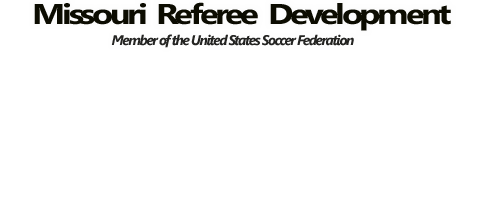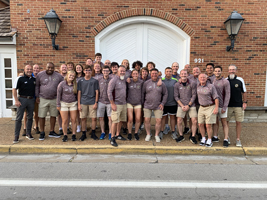The Diagonal System of Control (DSC)
For many years the DSC was the only USSF authorized method of control used. In recent years, with the advent of Small Sided Games the USSF has modified that to allow one referee and no assistant referee to be used for games on smaller fields with as few as 4 players a side, especially since most of those local rules of competition do not use Law 11 Offside. While it is noteworthy that there are many variations used with these changes to the traditional 11 vs 11 game, under the USSF umbrella there is still only one whistle allowed on the field of play. Even though the severe shortage of certified game officials has resulted in many "club" linespersons being used out of necessity, the USSF liability umbrella still in force only so long as the one whistle system is used regardless of whether the A.R. are certified or "club". For all 11v11 games the 2 man system (2 whistles) is never acceptable.
In the diagonal system of control, there are some key factors that must be adhered to in order to maximize effective performance by the team of officials, as well as adequately service the USSF game. The first is not what many think of when they talk about DSC, but it's one that many assessors bring up as part of their debrief after the game, especially when there appears to be inadequate communication between the members of the officiating crew.
1. Pregame
Unfortunately, it's common for officials to not arrive at the field in time to have an adequate pregame conference. It's also widespread for officials to be assigned back to back games with different AR's. Regardless of the reason, many breakdowns in game control start with inadequate pregame. When it comes to the Referee and the AR's not being on the same page, players, coaches, and spectators quickly lose confidence in the decisions of the game officials when they perceive there is inconsistent applications of the laws of the game. In order to avoid this the pregame conference has to instill teamwork and confidence between the officiating team by clearly and frankly discussing how or what the referee expects his or her AR's to specifically do. This discussion must include what areas of the field the Referee expects the AR to cover from his/her vantage on the touchline in the DSC. If, for whatever reason, the Referee does not see something that is critical to maintaining consistency in match control the AR's has to feel empowered to step up and assist according to what he/she was discussed during the pregame. As an example, for an older very competitive game where the teams are known for being very fast on the counter attach, during the pregame the Referee asks the AR's to be prepared when play is deep in the corner at their end, to take more responsibility for fouls so the referee can quickly stay with potential clearing counter attacks. This will probably mean the AR's might need to verbalize if needed so the players know there are more than one set of eyes watching what they do. Of course, if an AR follows pregame, and takes into account what the Referee is calling and NOT calling so far in that game, the AR's flag for a similar foul should be acknowledged and supported by a whistle from the Referee.
2. Diagonal
Most Referees run what is described as a "standard diagonal". Generally that means AR1 runs the touchline in front of the home team's bench from the halfway line to the corner, and AR2 runs the opposite touchline. The Referee's diagonal runs corner to corner in the opposite side away from each AR. The word diagonal is the closest description to the path of the referee as is possible because in reality their true and effective path actually follows the general run of play or the ball. The Referee must strive to keep the area of play and the ball between himself/herself and the AR in that half of the field. He/She must also make eye contact with both AR's as often as possible to ensure they stay on the same page throughout the match. This also ensures that the Referee promptly sees and acknowledges any signal or support from that AR. Usually the interaction and feedback at the pregame tells the referee if the AR's are comfortable with giving game management assistance in their quadrant of the field. If the Referee elects to let the AR give the additional support, then the Referee has to be prepared accept, or even overrule, without negatively impacting the teamwork. Regardless of whether the acknowledgement to the AR is overt or covert, effective and seasoned Referees know that it is critical for teamwork that the AR's feel they are an important part of the officiating team. The word "diagonal" should not be taken literally, nor should Referees be a slave to their diagonal. The diagonal only works if it's varied enough to keep the AR in sight and yet give the Referee the optimum angle to see what needs to be seen.
3. Reading of the game and positioning
On the DSC, the actual diagonal the Referee uses must constantly vary according to his/her reading of the flow of play and the game as it changes. Usually the Referee's position is close as practical to the action without being "in" the play. This can vary from 5-10 yards behind attacking play to being wide enough to see pre-ball contact and post-touch of ball fouls. The Referee must use this flexibility in position to ensure his/her diagonal allows play to flow and yet still be able to be where he/she needs to be when he/she needs to be there. That is easy to say, but can be a true challenge to for the Referee to execute over all 90 minutes of a game.
In summary, the DSC system of control is only effective if all game officials are on the same page. To accomplish that the pregame must be comprehensive, the referee's diagonal must be varied according to the flow of the game and involve all the members of the officiating team, plus the reading of the game has to be consistent among all the team of game officials.





